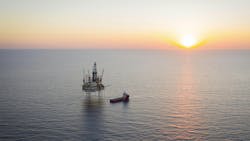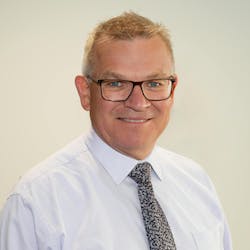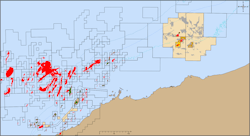Carnarvon Energy CEO: FID on Dorado project expected this year
Editor's note: This feature first appeared in the May-June 2024 issue of Offshore magazine. Click here to view the full issue.
By Bruce Beaubouef, Managing Editor
For the past two years, West Perth-based Carnarvon Energy has been seeking to sanction and advance the Dorado project, a field development project that it is developing in partnership with operator and majority-owner Santos. But inflation, disruptions in the supply chain, and environmental regulations have conspired to delay the project, which still awaits FID.
Getting that project going, and leading Carnarvon Energy into the energy transition are among the key goals being advanced by CEO Philip Huizenga. He joined Carnarvon in early 2007 as Principal Petroleum Engineer and was quickly promoted to Chief Operating Officer. Last December, after a flurry of board and management changes, Huizenga took over as CEO, a role that also incorporated his duties as chief operating officer.
Huizenga has an extensive engineering background with nearly 20 years in the oil and gas industry, including many years of rig exposure at offshore sites and in remote locations, and with several years reservoir engineering experience.
When he first joined the company, he oversaw a rise in output at the onshore Wichian Buri fields in Thailand from about 100 barrels per day to 15,000 barrels per day, followed by the eventual sale of the Thai assets in 2014. That helped fund Carnarvon’s play-opening exploration campaign in the Bedout basin offshore Western Australia, which kicked off with the Phoenix South discovery in 2014, followed by the 2016 Roc discovery and the game-changing 2018 Dorado discovery.
Recently, Huizenga spoke with Offshore to provide an update on the Dorado project, Carnarvon’s E&P campaigns in the Bedout basin generally, and the ways in which Carnarvon is working to promote the energy transition and environmental safety.
***
Offshore: What led Carnarvon Energy to explore for hydrocarbon opportunities in the Bedout (sub) basin? Can you talk about the geology that makes this area promising, and the potential size of the reserves?
Huizenga: Carnarvon first acquired exploration licences in the Bedout sub-basin in 2009 and what attracted us to the area was hydrocarbon discoveries from the early 1980s at wells in Phoenix 1 and 2. There was evidence of great reservoir from these wells and the nearby Keraudren-1 well, however, a lack of modern 3D seismic data meant the area was unloved and overlooked for decades.
Now we have extensively covered the Bedout sub-basin with modern and high-tech 3D data, we have enjoyed tremendous exploration success. Our exploration success rate sits around 67%, with the discovery of Dorado in 2018 – the largest offshore oil discovery made in waters off Australia in three decades – followed by the discovery of Pavo in 2022. Dorado’s liquid 2C resource estimate sits at 162MMbbls (Gross) and consists of a light, sweet crude, condensate low in CO2 gas and LPGs. Pavo holds a 2C liquids resource estimate of 43 MMbbls.
Excitingly, the identified exploration upside potential across Carnarvon’s permits in the Bedout is 9TCF of gas and 1.6 billion barrels of oil (Pmean, Gross). This prospective resource estimate has been calculated across top targets identified in the Ara, Wallace, Wendolene, Starbuck and Pavo South clusters within our four Bedout exploration licence areas.
Offshore: Are there any unusual challenges in drilling and producing from these areas in the Bedout (sub) basin?
Huizenga: Drilling to date in the Bedout has been relatively straightforward, with our targets located in shallow (less than 90 m) water off the North-West Shelf. The area is relatively proximate to ongoing oil and gas activity, so access to drilling and related services is generally available. Rather than challenges, we’ve had tremendous success when it comes to producing. We’ve performed two extensive well tests at Roc-2 in 2016 and Dorado-3 in 2019, both proving that wells in these reservoirs are capable of prolific rates, with equipment constrained rates of up to 50 MMscf/day of gas and 12,000 b/d of oil being achieved.
One of the other key advantages when it comes to production for Carnarvon and its joint venture partners is the proximity of the Pavo field to Dorado. Being only 46 km away means we can achieve economies of scale by plugging production from the Pavo field into Dorado production facilities through a simple low-cost tie-back design.
The single biggest barrier to conducting further drilling in the Bedout is scarce availability of suitable rigs in Australia, which means further drilling has been deferred to at least 2025.
Offshore: Can you provide us with an update on the Dorado project? Is there a new timeframe for the FID? Has the field development scheme changed or evolved?
Huizenga: Carnarvon has been working diligently with its joint venture partners towards achieving FID in 2024. Recent updates to the Phase 1 liquids development project design have focused on improving economics through optimised utilisation of the proposed production facilities. This will provide better value by reducing upfront capital outlay, optimising the production rate and capacity in keeping with a phased development approach, and potentially expediting the pathway to first oil.
Additionally, the joint venture has been exploring and assessing FPSO vessel conversion and redeployment options that could further bring down capital expenditure below the original US$2 billion guidance, and put Carnarvon in a position to fully fund its 10% share of the development. Carnarvon’s balance sheet remains strong with A$181 million in cash as of March 31, 2024, no debt and US$90 million carry from CPC Corp. – Taiwan’s national energy producer – on the Dorado development.
Offshore: Have the challenges on getting the Dorado project to FID been more on the regulatory front, or the cost/supply chain front?
Huizenga: Like any project, getting Dorado FID-ready has required balanced management of many moving parts. From a production permitting perspective Dorado is already sanctioned through its Offshore Project Proposal (NOPSEMA) and Production Licence (NOPTA) approvals last year.
Carnarvon and operator Santos have commenced compiling Environmental Plans (EPs) for activity relating to Dorado development and production, which are anticipated to be submitted for material approval ahead of FID. While in the recent past there was a period of offshore environmental regulatory instability, confidence is returning to the sector as witnessed by the raft of environmental plan approvals and offshore sector activity, particularly in the last six months.
Offshore: Are there any other reserve prospects that could feed into the Dorado architecture, besides the Dorado and Pavo fields?
Huizenga: We are eager to get into drilling campaigns at a number of prospective future oil and gas fields, such as Ara, Wallace, Wendolene, Starbuck and Pavo South clusters within our four Bedout exploration licence areas. These prospects could either add to the Dorado and Pavo fields in maintaining efficient use of the proposed Phase 1 liquids facilities at Dorado, or form the backbone for a future Phase 2 gas export system.
We almost have an embarrassment of potential targets, and through our systematic approach to exploration, we are confident of future discoveries being tied into Dorado or other future facilities.
Offshore: To what extent has Carnarvon Energy secured deals with engineers, contractors or suppliers, ahead of FID? Is the supply chain a concern?
Huizenga: Working on a project of the quality and high-profile project given Dorado is the largest undeveloped liquids project currently in Australia, is very attractive to many in the industry. Since we are still working towards a final investment decision targeted towards the end of this year, we are in active discussions with appropriate contractors and suppliers who will work with us to make Dorado a fantastic project.
While we did see some supply chain concerns a few years ago, and that led us to defer an FID decision until later this year, our view of the market is that these concerns are less applicable today.
Offshore: Can you talk about the respective roles of Santos, Carnarvon Energy, and CPC Corp. in the development of the Dorado project?
Huizenga: The joint venture welcomed the arrival of CPC Corp. in 2023 following Carnarvon’s divestment of 10% of its Bedout assets. Santos as the majority project shareholder (80%) remains the operator and is driving the pathway to development and production. The Carnarvon team works closely with Santos and CPC to assess, improve and implement project design, the pathway to FID and ultimately development and production.
Offshore: What led to the concept for a fixed wellhead platform and an FPSO? Can you provide an update on the engineering and construction of these facilities?
Huizenga: The Dorado field lies approximately 150 km from the coast and around 300 km from other oil and gas facilities. This distance from infrastructure led to the decision to design stand-alone facilities, such as a floating production, storage and offloading (FPSO) vessel.
Being located in relatively shallow water at around 85-90 meters allows for the use of a well head platform (WHP) to house the wells. The Dorado subsurface field is a very compact structure and hence all of the hydrocarbons are able to be accessed by drilling from a single WHP, central to the field. The development concept of a WHP and FPSO is common in the industry, and similar to other facilities in the North-West Shelf, giving more assurance that this is the preferred concept.
Carnarvon recently outlined some optimization to the base concept, allowing for an overall lower cost for the same design. Work is ongoing on the engineering ahead of construction expected to commence next year once a final investment decision has been made.
Offshore: What types of power generation will be employed on the wellhead platform and FPSO? Will there be any emissions reductions technologies?
Huizenga: Given the remote location of the facilities, power generation will primarily use a fraction of the extensive gas resources available, with most of the gas produced being reinjected to both enhance liquids production and storage for a future Phase 2 gas export system. Emissions reductions are being engineered into the project, with systems such as waste heat capture being integral to the project.
Offshore: Can you provide an update on what Carnarvon Energy is doing to advance the energy transition?
Huizenga: Carnarvon has been actively working to decarbonize and offset its emissions, and we are currently operating as a net zero carbon emitting company. We’ve also been acquiring Australian Carbon Credit Units (ACCUs) on the market to offset emissions from Dorado, accumulating enough to date to offset the project’s first five years of production, and ensuring we are prepared to operate within the safeguard mechanisms as outlined by the regulatory authorities.
About the Author
Bruce Beaubouef
Managing Editor
Bruce Beaubouef is Managing Editor for Offshore magazine. In that capacity, he plans and oversees content for the magazine; writes features on technologies and trends for the magazine; writes news updates for the website; creates and moderates topical webinars; and creates videos that focus on offshore oil and gas and renewable energies. Beaubouef has been in the oil and gas trade media for 25 years, starting out as Editor of Hart’s Pipeline Digest in 1998. From there, he went on to serve as Associate Editor for Pipe Line and Gas Industry for Gulf Publishing for four years before rejoining Hart Publications as Editor of PipeLine and Gas Technology in 2003. He joined Offshore magazine as Managing Editor in 2010, at that time owned by PennWell Corp. Beaubouef earned his Ph.D. at the University of Houston in 1997, and his dissertation was published in book form by Texas A&M University Press in September 2007 as The Strategic Petroleum Reserve: U.S. Energy Security and Oil Politics, 1975-2005.




